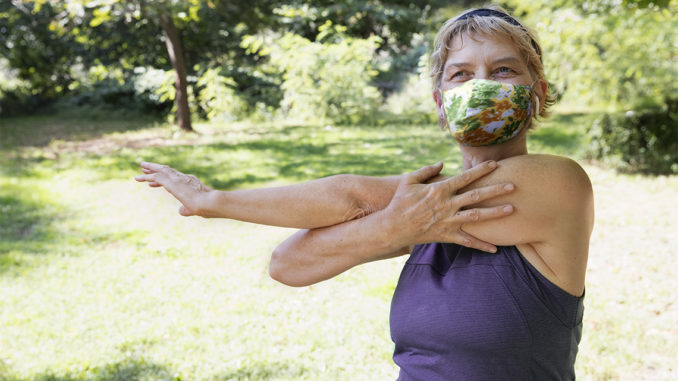
1. Choose the right fabric
A light, breathable material like cotton will likely keep your face cooler than medical and N95 masks made from synthetic materials, and in the right configuration can be effective in preventing contagion, according to new research by Taher Saif, a professor of mechanical science and engineering at the University of Illinois.
Saif’s team tested 10 common fabrics, from 100 percent cotton to polyester and silk blends, to see which best balance comfort and droplet-blocking impermeability. The “sweet spot,” he says, is a two-layer mask made from a cotton T-shirt, which comes close to matching a surgical mask’s efficiency in stopping potentially infectious droplets from coughs and sneezes and is about twice as breathable.
All-cotton tested best, but up to 40 percent polyester will do the job, Saif says. “I’m not a cloth expert. I just buy things from Walmart and Target,” he adds with a laugh. “Our study showed that if you have these layers on top of your mouth and nose, you don’t have to have an official mask where it goes with the elastic behind your ears. You can just wrap it around your nose and mouth, like a bandana.”
Lighter, softer cotton coverings can also help you avoid chafing, heat rash or inflaming a skin condition like eczema or dermatitis, says Carrie Kovarik, an associate professor of dermatology at the University of Pennsylvania’s Perelman School of Medicine and a member of the American Academy of Dermatology’s COVID-19 task force.
“They make masks out of a lot of different material, so you want to feel it and make sure it’s something that feels soft against your skin,” she says. “A lot of people are making masks for fashion, they want it to look nice and pretty on the face, but make sure it feels good.”
2. Keep it dry
Cotton traps less air and moisture than standard medical and industrial masks, and it’s more absorbent, but if it gets damp due to breathing and sweating it can be less effective in filtering respiratory particles, not to mention uncomfortable and abrasive to the skin.
“Try to stay in well-ventilated locations to keep air and vapor mixing, which can help evaporate any extra water (and also keep the rest of your skin/body feeling cooler),” says Jennifer Vanos, a biometeorologist at Arizona State University who studies the effects of heat on health.
Vanos also suggests trying masks made of especially absorbent materials like bamboo, which “can absorb up to three times the amount of water as cotton.” Hemp also wicks moisture well, and washable hemp-blend masks are widely available online, although like bamboo they tend to cost more than cotton face coverings.
3. Time trips to beat the heat
Avoid going out at the hottest parts of the day and for extended periods. Stop at home between errands if you can, to cool off and doff your mask. When you do have to be out, stay well-hydrated and seek the shade.
Being cognizant of the heat is about much more than keeping your mask fresh. “We have major issues every summer with heat exhaustion and heat stroke and heat-related deaths,” the Mayo Clinic’s Poland says, and older adults are “definitely at increased risk.”
An ice pack or damp cloth applied to the head or neck can help you cool off — just take care not to get your mask wet or touch your face. Poland notes other heat hacks he’s observed traveling in parts of Asia where mask-wearing has long been routine.
“They more often carry a hand-powered fan or small, battery-powered fan,” he says. That trick comes with a caveat — if you are “around a lot of people’s exhalation, you’re just fanning that air at yourself” — but with sufficient social distancing you may be able to use a fan to stay comfy while still protecting yourself.
“The other thing you see a lot of people doing in Asian countries during the summer is shading themselves with an umbrella,” Poland says. “Turns out that things like that actually do help.”
4. Skip the makeup
Heat and perspiration mixed with makeup or oily skin care products makes for a gunky mess under your mask. “You don’t have the ability to have sweat evaporate when you have the mask on. It all sits there and collects,” says Kovarik, the dermatology professor. That clogs pores and contributes to the lower-face skin eruptions that have been dubbed “maskne,” a combination of the words mask and acne.
Kovarik recommends masking up with your face clean, save perhaps for a bit of moisturizer (preferably with some SPF, if you plan to be out long). “Creams that have dimethicone in them are a good moisturizer but also is a barrier cream, so it creates some protection between your skin and the mask,” she says. “It will actually create a barrier to the friction.”
Another change to make to your skin care regimen: Avoid products with retinoids or salicylic acid, which some older people use to diminish wrinkles or sun damage.
“Those can be very, very irritating if used under occlusion or under some kind of covering. We don’t want to put them under the mask,” Kovarik says. “If [people] are using those products, it’s better to put them on at night and then wash your face in the morning.”
5. Bring a spare
If you can’t keep your mask from getting icky and sticky, there’s no better remedy than swapping it for another. “I recommend people do that anyway,” whatever the weather, Poland says. “When you’re outside with the mask on, that mask has a limited lifespan.”
On especially hot and humid days, pack multiple masks, recommends Vanos, the heat expert. Just make sure to follow the other CDC safety recommendations when changing masks, like avoiding crowds and washing or sanitizing your hands.



Be the first to comment